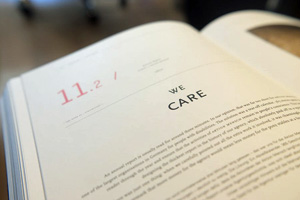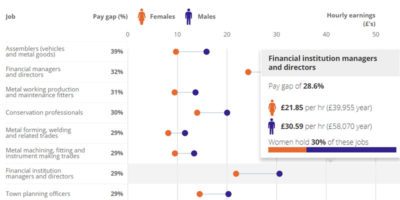Claire McCartney and Dianah Worman are Co-directors of Inclusive Talent – a diversity and talent management research, consultancy and facilitation organisation. They are also research and policy associates of the CIPD.

“…Massaging the figures is not a quick fix. It’s not the answer.…”
About Inclusive Talent
Our role at Inclusive Talent is to help organisations make sure that they develop everybody’s talent in the best kind of way to advantage their business. This requires an approach which is not just a quick fix. The way in which you treat people, reward them, recognise them, nurture them can put you in a much better position to attract and retain a productive and happy workforce. It is about valuing people and valuing differences.
Gender pay gap reporting deadline
I think some organisations might have been holding back because they wanted to coordinate what they were going to say with their annual reports and so on. Others who have come forward first have shown that they are in the vanguard of tackling the issues – being prepared to talk about it and share their experiences.
They are sharing that there is a way of doing things about dealing with people that puts you in a better position – it is not just about ‘fixing’ figures. It is about the way in which you ensure that gaps do not arise in the first place, or the ways in which you use any gaps to identify what the causes of those gaps are and fixing things, so those gaps gradually reduce.
There are all sorts of reasons why these gaps can occur and fixing things is about making sure that there is no gender difference in the way in which people are recruited, trained and developed to reach their full potential.
There are lots of things that happen people’s careers that can hold you back. It may be something you do yourself because of the way you are running your life – having children, whether you decide to have a long career break and so on, or whether you decide to re-train, for example. All that sort of stuff versus the ways in which people inside your organisation value how what you do makes a difference.
There is a complex mix of things that can lead to gaps between the ways in which men and women are paid and it is these gaps that show up some potential problem areas employers can rectify. It is not the same as lack of equal pay.
Difference between the gender pay gap and equal pay – it’s complicated…
You may not have any equal pay cases in your organisation but still have gender pay gaps. On the other hand, you could have no gender pay gaps but unequal pay because of the differences that occur in the ways you pay men and women for work that is exactly the same or of the same value.
Women sometimes end up being paid less than men because of the way the work they do is valued. Quite often research has shown that women who tackle really challenging jobs, and are very successful at doing it can get side lined into these difficult jobs that men wouldn’t choose to do and yet they are not being reimbursed at the right rate for the skills that they are using.
Essentially, equal pay should be for work that should be valued as being exactly the same or of equal value in terms of the contributions it gives to an organisation. There are various processes that organisations can use to actually come up with the answers. These are called job evaluations.
Job evaluation processes give you more objectivity to compare jobs and elements of jobs. I would not say that they are totally fool-proof however, because it is not just what a job is, and what the challenges of the job are, but the way that the job is being done that adds value to your business. It is therefore quite complicated. Equal pay issues have existed for a long time but we still seem to be having problems with it because it demands organisations to have a great deal of rigor to ensure that the ways in which they pay men and women are fair and equal.
Levelling the playing field
It becomes confusing when you get pay gaps when you compare the earnings of men and women generally. They could arise because you have a skewed gender balance in your workforce – you may have far more men in higher paid jobs than you have women, and many more women in the lower skill areas.
This shows the chances women have of getting towards more senior higher paying jobs are less equal than those of men. It means looking at why this is happening and what can be done to enable women to reach higher income levels in the same way men. That is where you can begin to tease out the building blocks that you need to develop in order to enable that to happen.
It may be by ensuring that you do not always recruit senior level people from the open market. Apparently, there is a tendency for men to bargain much better than women and therefore they tend to get paid more, and there are also more of them. There is more chance of women getting to the top if you nurture your talent pipeline. If you give them access to mentoring and make sure you have access to the right ‘platform’ jobs that lead to career development to those posts where they can earn more money.
It may mean that you need to be considering much more flexible working for the people you have already in order to make sure you smooth out these curves. It is vital for employers to use data and information to monitor who is getting what, including thorough and fair appraisals, access to training opportunities and so on. You can cut your data so that you understand the characteristics of your workforce much better than you otherwise would – that gives you clues about ways in which some people are not getting as much of a chance as others.
Not focusing on recruiting top people from the outside all the time by developing your talent pipeline removes the potential to have a skewed profile of earnings for very senior level people, as they did in all those headline cases we have had in the news recently.
Employers signalling how much they value their people
Training and nurturing people can bring advantages in terms of building employee loyalty. Employers have to make sure they understand what the people in their business are already contributing beyond the basics written into a job description, and that they are developing what they can do and helping them to do those things better so that they are rewarding them appropriately.
They are smoothing out to the distribution of their male and female workforce, and in doing that you are signalling how much you value people. It coincides with improving their business performance. There is increasing evidence of correlations between the numbers of women in senior positions and better business performance.
Working at this might sound like a time-consuming headache, but it is worth it to ensure you are not wasting talent – you are nurturing it, developing it and safeguarding the way in which it is loyal to your organisation.
Honesty is the best policy
Getting gender pay gap reporting right is vital for organisations’ authenticity – ensuring they send the ‘right’ messages to their customers, clients and their employees. One of the important messages about gender pay gap reporting is that it not just about reporting the figures and the timing of that, but is about the stories behind them.
This is where some organisations may have hesitated if they have identified gaps of various kinds, and they are embarrassed about them. Some organisations are concerned a gap will be damaging – how on earth are they going to explain in a narrative how these have occurred and what they are going to do about it to remove the gaps in the future?
Once employers have identified a gap, they have got to get their act together in understanding why it has happened and why, and look behind figures in order to explain those both to internally and to their stakeholders in ways that are honest and transparent, because honesty and transparency are what everyone is look for. If they hide behind a disguise they are only going to do themselves harm. Trust is absolutely vital to organisations to sustain how they are regarded.
Salary negotiation
This is an interesting issue because quite often organisations have an indicative salary when they are recruiting and they expect people to negotiate about this, probably the top end of the range. Recruiters have to make a judgement about a candidate’s application in terms of whether they have the ‘right’ bundle of skills and experience that the organisation is looking for, and what they are prepared to pay for that bundle. The problem is that the candidate has only got that top end as a marker about what they might be worth.
If the applicant is not very confident, or has not got enough to say about it or doesn’t think they can tick all the boxes, they are less likely to ask for the top end. That is where this issue of openness and honesty about the actual rate for the job, what organisations are prepared to pay, is key. If you have got the talent and skills the recruiting organisation is looking for, it shouldn’t really matter what you have been earning in the past because they should be able to make a judgement about whether on balance you have got what they are really looking for.
If another organisation has been prepared to pay you more for that, or less for that, then so what? Perhaps the organisation should stick its neck out to say: “This is the money we are putting on this role,” because it means that is what is important to them in order to sustain their business performance. If, for example, someone has worked with all these skills in a lower paying sector, so what? They can still do the job. Why should they be penalised?
I think this openness and this honesty has to start at the recruitment stage where you are saying up front: “This is the rate for the job, this is what we are expecting.” We must have at least this stuff. There may be some other exciting stuff that a candidate brings along, which is not spelt out. The recruiter might suddenly realise that is going to be extremely valuable to them, so then there is room for negotiation.
Paying women more versus pay men less
This is a conundrum. If you are fishing in an international talent pool, businesses will argue that you have got to be able to pay the rates for people who are internationally mobile in order to attract those candidates. That will probably mean that you are more likely to have potentially male and female candidates and you are saying: “My organisation wants to pay X amount of money.” You have stuck your neck out. If you are then going to cut that because a woman has applied, and you want to get that one woman, it is saying the opposite, isn’t it?
If you have not done your assessments properly in terms of how much you can afford to pay someone, how much you are prepared to pay someone, how much their job is worth in terms of the basics of that job, but also, the way in which someone does it, it doesn’t look terribly professional in the first place. It looks as if you are out of sync.
As the economy develops, some sectors are going to take off with jobs we’d never heard of before, but other jobs will tail off. One could argue that the rates for the job are what people are prepared to do for that job for. What can they get on the open market? Could we argue that everything has got to go up, or can it go down, as with the housing market?
I don’t think you should just instinctively hack back on the pay because you cannot afford to pay the women the same rate – you should have thought about that in the first place. That is part of organisations playing catch up. What is the narrative? What is the reason behind the men having such a lot of money and women having less? Why have men historically had access to job opportunities, training and so on which are valued so much, but women have not had the same access? That brings you back to developing your pipeline.
No quick fixes
It is complicated but there are no quick fixes. Massaging the figures is not a quick fix. It’s not the answer. You may have some things you can do better but certainly you are in for the long haul here – in order to get things right and you need to recognise it. This is where some organisations might be a bit scared, but they need to get to grips with the issue.
The Fawcett Society has just done some work about the need to strengthen legislation because equal pay is not working properly – it takes a long time to rectify, for example. The marketplace for talent could cause difficulties for organisations, but it depends on the state of the economy as to how much employers will be able to get away with. Awareness amongst women is better than it used to be so they are more able to map a way forward for their careers than they would have been in the past, armed with better information.

The problem is that organisations focus on doing their ‘day job’ and this is often not seen to be the issue we have been talking about, but this is vital if they want to survive. It is the key dimension to being successful. If you ignore dealing with the people dimension of your business, getting peoples’ commitment and making people recognise that you value them, you do so at your peril.
Improvements to the gender pay gap reporting system
Dimensions that can inform the gender pay gap include ability to work part time, linked to the flexible working agenda. Those things open employers’ eyes to the different ways of running a business and the need to work smarter, whilst ensuring fairness.
You could argue if I’m purchasing a bundle of skills as an employer, regardless of whether I am buying this quantity or that quantity, the basic rate should be the same, whether it’s about employing people full time or part time. I think we have progressed from the time where employers feel they should pay people working full time more because they are buying in larger quantities.

Looking across the piece is important so you understand the nuances in the ways employee profiles are influenced. It may be something that you are not aware of at all or something that is happening but has not surfaced. There is a lot more that we could inspect further down the line, but you have got to start somewhere. Employers are becoming much more sophisticated because they are keeping more of this data and they can see how some people’s careers are potentially being compromised because of these particular characteristics.
I think the main thing is to encourage openness and honesty because that helps people to trust the organisation more, especially if you set out an agenda you aim to deliver, keeping stakeholders informed as you move forward and discover more. Your stakeholders and people in the population are increasingly expecting this kind of information. Young people coming out of university are increasingly expecting it. You really need to pull your socks up so you do not miss out.
Coming up next
We are looking forward to working on an initiative in the Isle of Man because they have introduced legislation on equality similar to the one that we have in our jurisdiction and we are hoping we can work with some of the employers out there to help them to get to grips in making progress.
http://www.inclusivetalent.co.uk/
dianah.worman@inclusivetalent.co.uk
https://twitter.com/dianahworman
claire.mccartney@inclusivetalent.co.uk
https://twitter.com/cmccartneycipd
Meeting image credit: By www.konftel.ru (www.konftel.ru) [GFDL (http://www.gnu.org/copyleft/fdl.html) or CC BY-SA 3.0 (https://creativecommons.org/licenses/by-sa/3.0)], via Wikimedia Commons







